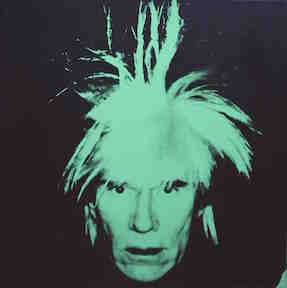Opinion
Andy Warhol: Dead for 30 Years, But Still a Wizardly Presence
THE DAILY PIC: In a new Skarstedt self-portrait show, Warhol isn't depicting his death but rather his magician's powers.

THE DAILY PIC: In a new Skarstedt self-portrait show, Warhol isn't depicting his death but rather his magician's powers.

Blake Gopnik

THE DAILY PIC (#1737): Today is the 30th anniversary of the death of Andy Warhol, so it’s tempting to see my Pic for today, one of his so-called Fright Wig self-portraits from 1986, as expressing some kind of premonition of coming demise. That’s not totally far-fetched: As I just wrote in the New York Times, Warhol had been seriously ill for some while by the time he was painting these pictures. On the other hand—as I also point out in my Times story—his death was pretty much just a case of bad luck so he couldn’t have known it was coming.
Studying the image for today’s column, which is from a show of five huge Fright Wigs that opens tomorrow at Skarstedt gallery in New York—and that I’m told was not planned with Warhol’s death in mind—I came to a quite different reading of it. One of the most striking things about the image is its total lack of neck, leaving Warhol’s head floating, death’s-head-like, in the middle of the canvas. Looking at it this week at Skarstedt, I suddenly realized that I’d seen that effect before, in a context that had absolutely nothing to do with death but all kinds of connections to Andy: His image echoes the first appearance of the Great and Powerful Wizard of Oz—as a glowing green head floating huge and free against a dark background—from the 1939 movie. So rather than presenting himself as a token of a coming absence that he couldn’t have predicted, Warhol is presenting himself as a giant, magical presence who rules a universe that lives in his shadow. But also, more poignantly, as the insignificant little “man behind the curtain” who dominates his world through an artist’s tricks and misdirections.
Warhol once spoke about how painful it was to have to don his “Andy suit” each time he went out to play himself in the wider world. The late self-portraits depict the suit, and the pain. (Image ©2017 The Andy Warhol Foundation for the Visual Arts, Inc. / Artists Rights Society (ARS), New York)
For a full survey of past Daily Pics visit blakegopnik.com/archive.